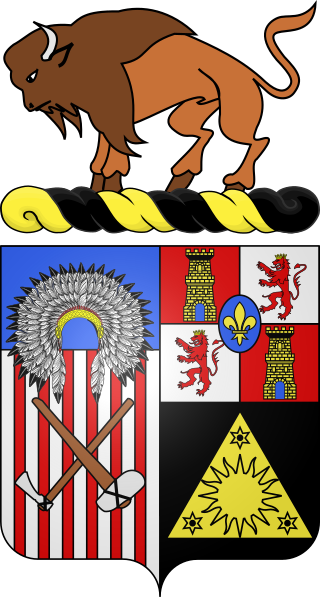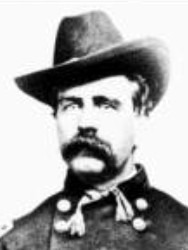
Buffalo Soldiers were United States Army regiments formed during the 19th century to serve on the American frontier that primarily comprised African Americans. On September 21, 1866, the 10th Cavalry Regiment was formed at Fort Leavenworth, Kansas. The nickname "Buffalo Soldiers" was purportedly given to the regiment by Native Americans who fought against them in the American Indian Wars, and the term eventually became synonymous with all of the African American U.S. Army regiments established in 1866, including the 9th Cavalry Regiment, 10th Cavalry Regiment, 24th Infantry Regiment, 25th Infantry Regiment and 38th Infantry Regiment.

Thomas Ward Custer was a United States Army officer and two-time recipient of the Medal of Honor for bravery during the American Civil War. A younger brother of George Armstrong Custer, he served as his aide at the Battle of Little Bighorn against the Lakota and Cheyenne in the Montana Territory. The two of them, along with their younger brother, Boston Custer, were killed in the overwhelming defeat of United States forces.

Fort Leavenworth National Cemetery is a United States National Cemetery located on Fort Leavenworth, a United States Army installation north of Leavenworth, Kansas. It was officially established in 1862, but was used as a burial ground as early as 1844, and was one of the twelve original United States National Cemeteries designated by Abraham Lincoln. The cemetery is the resting place of nine Medal of Honor recipients, but most are the less famous casualties of war. It was named for Brigadier General Henry Leavenworth, who was re-interred there in 1902 from Woodland Cemetery in Delhi, New York. Administered by the United States Department of Veterans Affairs, it occupies approximately 36.1 acres (14.6 ha) and was site to over 22,00 interments, as of 2020. It is maintained by Leavenworth National Cemetery.

Fort Bayard National Cemetery is a United States National Cemetery in the Fort Bayard Historic District, near Silver City, New Mexico. It encompasses 18.8 acres (7.6 ha), and as of the end of 2020, had 6,000 interments. It is one of two national cemeteries in New Mexico, and is administered by Santa Fe National Cemetery.
The Gaujot brothers, Antoine August Michel Gaujot and Julien E. Gaujot, are one of the five sets of brothers who have received the Medal of Honor and the only pair to have been so honored for actions in different actions. Both brothers attended Virginia Polytechnic Institute and State University, but neither were graduates of the university.

The 10th Cavalry Regiment is a unit of the United States Army. Formed as a segregated African-American unit, the 10th Cavalry was one of the original "Buffalo Soldier" regiments in the post–Civil War Regular Army. It served in combat during the Indian Wars in the western United States, the Spanish–American War in Cuba and in the Philippine–American War. The regiment was trained as a combat unit but later relegated to non-combat duty and served in that capacity in World War II until its deactivation in 1944.

The 1st West Virginia Cavalry Regiment served in the Union Army during the American Civil War. Although it started slowly, it became one of the most active and effective of the West Virginia Civil War regiments—and had 14 Medal of Honor recipients, the most for any West Virginia regiment during the war. It was originally called the 1st Virginia Cavalry, not to be confused with the Confederate 1st Virginia Cavalry. Some reports added "Union," "Loyal" or "West" when identifying this regiment. After the Unionist state of West Virginia was officially admitted to the Union in 1863, the regiment became the 1st West Virginia Cavalry Regiment. The National Park Service identifies it as the 1st Regiment, West Virginia Cavalry.
Thomas Boyne was a Buffalo Soldier in the United States Army and a recipient of America's highest military decoration—the Medal of Honor—for his actions in the Indian Wars of the western United States.

Clinton Greaves was a Buffalo Soldier in the United States Army and a recipient of America's highest military decoration—the Medal of Honor—for his actions in the Indian Wars of the western United States.

George Jordan was a Buffalo Soldier in the United States Army and a recipient of America's highest military decoration—the Medal of Honor—for his actions in the Indian Wars of the western United States.

Thomas Shaw was a Buffalo Soldier in the United States Army and a recipient of America's highest military decoration – the Medal of Honor – for his actions in the Indian Wars of the western United States.

Augustus Walley was a Buffalo Soldier in the United States Army and a recipient of America's highest military decoration—the Medal of Honor—for his actions in the Indian Wars of the western United States.
Adam Paine, or Adam Payne, was a Black Seminole who served as a United States Army Indian Scout and received America's highest military decoration—the Medal of Honor—for his actions in the Indian Wars of the western United States.

Henry Capehart was a surgeon and officer in the U.S. Cavalry during the American Civil War. He received the Medal of Honor for saving the life of a drowning soldier while under fire at Greenbrier River, West Virginia, on May 22, 1864.

Charles E. Capehart (1833–1911) was an officer in the U.S. Cavalry during the American Civil War. He received the Medal of Honor for action following the Battle of Gettysburg on July 4, 1863.

Charles H. Marsh was a Union Army soldier in the American Civil War and a recipient of the United States military's highest decoration, the Medal of Honor, for his actions during a skirmish in the Valley Campaigns of 1864.

Levi Shoemaker was a Union Army soldier during the American Civil War who received the U.S. military's highest decoration, the Medal of Honor.

The Medal of Honor (MOH) is the United States Armed Forces' highest military decoration and is awarded to recognize American soldiers, sailors, marines, airmen, guardians and coast guardsmen who have distinguished themselves by acts of valor. The medal is normally awarded by the president of the United States, but as it is presented "in the name of the United States Congress", it is sometimes referred to as the "Congressional Medal of Honor".

William Henry Powell was an American soldier who fought for the Union in the American Civil War. He was a leader in the iron and nail business before the war, and his leadership abilities proved useful in the military. Powell began as a captain, and quickly ascended to higher roles in the cavalry, including commanding a regiment, a brigade, and then a division. Powell was awarded his country's highest award for bravery during combat, the Medal of Honor, for heroism at Sinking Creek, Virginia, when, as leader of a group of 22 men, he captured an enemy camp and took over 100 prisoners. This was accomplished without the loss of any of his men on November 26, 1862. He was honored with the award on July 22, 1890.


















